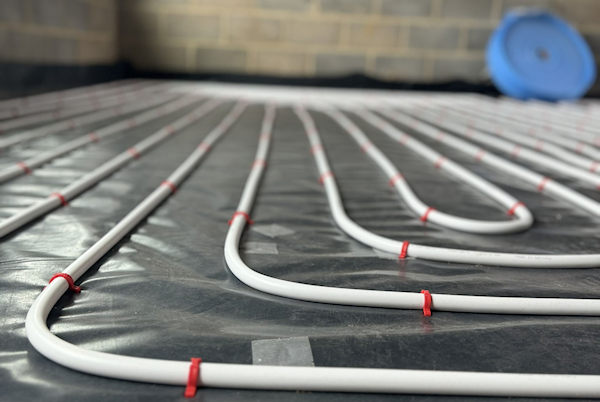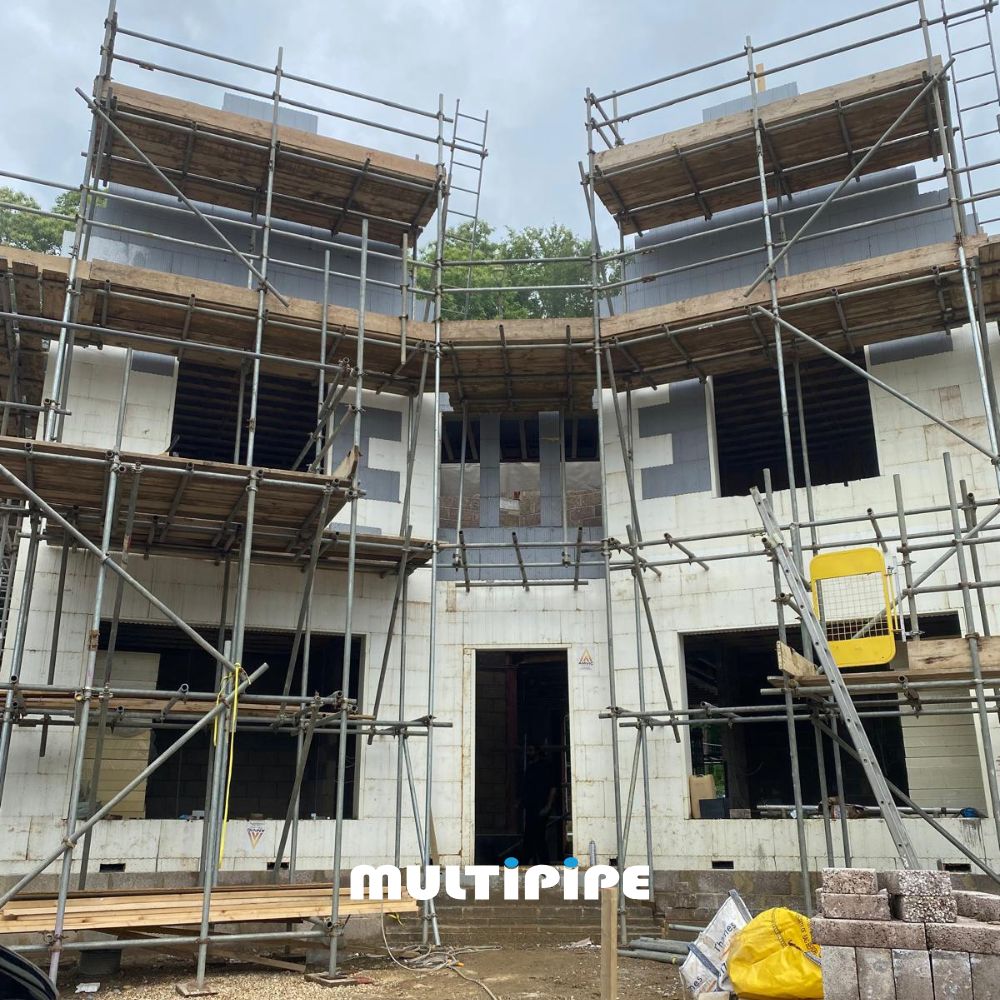
Underfloor Heating Manifolds – Explained
As underfloor heating installation grows increasingly popular, it’s important to understand the critical parts of a UFH system and how they operate. This blog will explain what an underfloor heating manifold is and how it works.
Manifolds are the central control hubs of water in underfloor heating systems. They manage water flow rates and any room zoning you have. In addition, manifolds work to circulate heated water through the UFH pipes to provide each system zone with comfortable, energy-efficient heating.
What is an Underfloor Heating Manifold?
Manifolds are crucial parts of a water-based underfloor heating system. They connect the heat source to the underfloor heating pipework and act as the termination point for the floor circuits (pipework). Manifolds circulate heated water from the heat source (e.g. boiler) through the underfloor pipework whilst controlling the flow rates. If a mixing unit is used, they also control the circuit temperature.
Hydronic underfloor heating systems generally consist of pipework installed on specific UFH insulation boards or within the screed. UFH pipework can be laid in various patterns (e.g. bifilar) to form circuits. A single circuit will be for an individual room or area and multiple circuits for larger rooms or open areas – these areas are called zones. Each zone connects to a centrally located manifold, allowing independent control of the zones. In addition, manifolds can control multiple circuits simultaneously, allowing you to warm different rooms to different temperatures. Each zone is typically managed by a zone-specific thermostat installed within the heated area.
Multipipe has a range of manifolds that can control the underfloor heating for up to 12 circuits, each with up to 120 meters of connected pipework. Our manifolds will maintain a consistent and even distribution of the water around the floor circuits at the correct temperature and flow rate.
The Component Parts of a Multipipe Manifold
Manifolds comprise six key parts, each performing a vital function in the effective operation of the underfloor heating system:
Wiring Centre
A wiring centre controls the electrical aspect of the underfloor heating system. It enables a connection between the heat source, thermostat and manifold. The wiring centre coordinates the heating system’s operation as it usually connects the Room thermostats to the individual rooms (using actuators) and centralises the pump and boiler operation.
Manifold Mixing Unit
A mixing unit (if fitted) comprises of three main parts: the mixing valve, circulating pump and the top assembly (consisting of air vent and temperature gauge). It helps blend incoming boiler water temperature to a safe operating temperature for the floor circuits. This helps to keep at the designed temperature. The main reason for using this is that you have a system that needs to operate at different water temperatures, i.e. Radiators that cannot run at low temperatures. You set the heat source to the desired flow temperature for the rad system to work, then locally blend the water for the UFH circuit.
Air Vents and Drain Valves
Air vents and drain valves are found on the manifold’s ‘flow’ and ‘return’ bars, and their function is to help in the initial filling and venting of the UFH system.
Flow Gauges
Flow Gauges are mounted to the flow bar of the manifold, one per circuit. These help you to see the flow rate through each zone. The flow gauges are set during installation to configure the correct flow rate for the circuit and provide the designed heat output for that circuit – which is determined by the floor build-up and heat losses of the area.
Manifold Isolation Valves and Valve Pins
Isolation valves permit the isolation and testing of the manifold without affecting the rest of the system. These valves are connected to the manifold bars or the Mixing Unit (if used).
The Valve Pins (these sit on the return bar of the manifold) allow the system to be filled, drained, and pressure tested by controlling water flow through the individual floor circuits. Once this operation is complete, the Valve Caps are removed and replaced with Actuators to provide individual circuit control.
Actuator
Actuators connect to the wiring centre and are attached to the valve pins of the manifold. This connection allows the actuators to open and close each circuit so the water can flow through the system. Allowing for individual room control.
How does a Multipipe Underfloor Heating Manifold work?
The manifold connects the heat source (such as a boiler or heat pump) with underfloor heating pipes and regulates the incoming water temperature via the mixing unit. The manifold then sends this warm water through all the floor circuits to create an energy-efficient heating solution.
A UFH manifold consists of a flow bar (with flowmeters) and a return bar (with valve pins). This allows water to flow down the separate pipe circuits installed into individual zones. Each area can be balanced and individually controlled as required by the end-user.
The top row has adjustable valves with a see-through cap that shows the flow rate. The flow rate increases or decreases by turning the valve. This allows the system to have the desired flow rate in each circuit.
For example, if a 100m coil is in the sitting room and a separate 80m loop in the kitchen, both pipe sets will return to taps on the manifold. Due to the different pipe lengths, adjustments will need to be made to ensure they balance, as water will always take the easier route and starve the sitting room circuit.
The bottom bar is where our actuator control sits to control each loop.
Connect the Heat Source to the Circuits
The primary heating circuit connects to the heat source, which supplies water to the manifold (via the mixing unit if used). The heat source provides water to the manifold mixing valve to guarantee the intended water temperature (usually 20 – 60°C). However, if the heat source can constantly give the required water temperature without over-heating, you probably won’t need a mixing unit, which helps with the efficiency of your heat source.
The mixing unit regulates the water temperature by a wax-filled thermostatic head as heat passes through the wax melts. As a liquid, this takes up less space, so it shuts the valve as it resolidifies the wax expands, pushing the valve open again. This then blends the heating water from the primary circuit with cooler water from the floor circuits to achieve the desired heating temperature. This temperature is configured during the installation to match the designed heat requirements, which are affected by heat losses, floor construction and heat outputs.
Distribute the Heated Water
When the flow rates are correct, the manifolds flow bar delivers optimally heated water into the floor pipes. After circulating, the water goes back to the manifold via the return bar. The return bar has circuit valves usually mounted with actuators. The thermostat instructs the actuators to open and close to allow water to flow into the floor circuits to warm the room as required.
Control the Manifold
The Wiring Centre efficiently controls the manifold and its electrical components. The wiring centre connects the heat source, thermostats, manifold actuators, pumps, and zone valves. For example, if a thermostat calls for heat in a specific zone, the Wiring Centre will supply voltage to the relevant Actuators. By opening the Valves Pin, warm water can flow through the circuits. The Wiring Centre also demands heat from the boiler, opens any zone valves fitted and operates the Mixing Unit Pump.
Multipipe have a range of smart programmable thermostats that allow users to control their heating remotely when combined with a smart gateway. The use of smart thermostats helps reduce the end users’ carbon footprint and provide long-term savings on energy bills.
Where should I position the Underfloor Heating Manifold?
The position of the manifold can greatly influence the efficiency of a UFH system. The ideal location for the manifold is central to the heating zones. The location should be somewhere that can easily be accessed for future maintenance. In addition, a central manifold location will help ensure that pipe feed lengths are kept to a minimum, thus ensuring that the water evenly and efficiently reaches each area of the system, ensuring no overheating.
More than one manifold may be needed for larger projects. For example, if underfloor heating is to be installed across multiple floors, we recommend installing a separate manifold on each floor.
Do I need more than one Underfloor Heating Manifold?
In a standard installation, it is usual to see a separate manifold for each floor of the property.
However, where the home has underfloor heating downstairs and radiators upstairs, it is possible to use only one manifold if the radiator circuit is plumbed in a traditional branch system.
If you choose a manifold for the radiator circuit, then you can;
- offer up the same level of control as your UFH circuit downstairs,
- allow individual rooms control
- match it into the same smart system.
Suppose you can size radiators to operate at a lower temperature (generally by increasing their size). Then you don’t have to fit mixing valves. Then turning the heat pump/boiler to a lower temperature/heat curve can massively increase your system efficiency.
However, care must be taken to balance the system as the two systems run differently. For example, the radiators could have a lot less resistance than the underfloor heating circuits and therefore get the lion’s share of the heat, leaving the underfloor heating circuits starved.
Most new installations are an unvented system. Therefore, It is covered by Part G of the Building Regulations, which requires that the manifold be installed by an experienced and suitably qualified professional. It is up to the installer to consider the end-users wishes as to the location. Ultimately the manifold must be installed in a safe and efficient site.
Multipipe provide a design and supply service for bespoke underfloor heating systems and manifold radiator solutions. We will work with you to ensure you install an optimal system, including advice on locating the manifold.
You’ll find helpful videos regarding UFH installation on our YouTube channel











